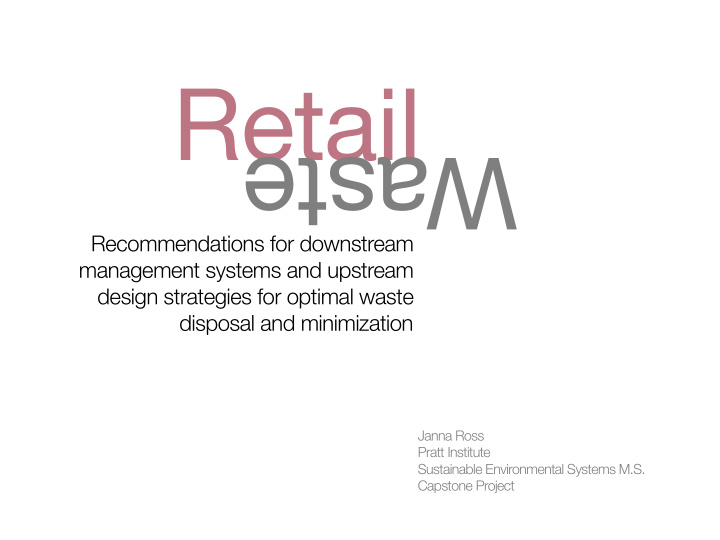



1 Retail Waste Recommendations for downstream management systems and upstream design strategies for optimal waste disposal and minimization Janna Ross Pratt Institute Sustainable Environmental Systems M.S. Capstone Project
2 Source: https://goo.gl/images/3emx8a
Overview 3 01 Client and Project Introduction 02 Retail and Waste in the US 03 Corporate Social Responsibility 04 Methodology 05 Client Recommendations 06 The Future of Retail https://goo.gl/images/foJOww
4 Retailer X
5 20% 42M 14% 3.8M Buildings Stores Jobs GDP Source: USGBC and National Retail Federation
6 Waste Management Hierarchy Most Preferred Source Reduction & Reuse Recycling / Composting Energy Recovery Treatment & Disposal Least Preferred Source: EPA
7 • Preserves natural resources ! • Reduces emissions ! • Conserves energy ! • Reduces water pollution ! • Reduces pollution ! • Saves energy ! • Reduces waste toxicity ! • Supplies raw materials ! • Saves money for businesses and • Creates jobs ! individuals ! • Stimulates development of green technology ! • Conserves resources ! • Reduces need for new landfills and combustors ! Source Recycling & Reduction & Composting ! Reuse ! Source: EPA | https://craftbits.com/project/diy-copper-pvc-wall-planter/ | https://www.shutterstock.com/search/reduce+reuse+recycle
8 Triple Bottom Line Corporate Social Responsibility (CSR) ! People ! Planet Profit
9 Methodology Case Studies and Industry Standards ! Sources: https://goo.gl/images/CnA4ho | https://goo.gl/images/vh466e | https://goo.gl/images/TfGnWW | https://goo.gl/images/Be7CXK
10 Retailer X has 9 stores in the Retailer X has 9 stores in the US with 4 outlet locations. US with 4 outlet locations. These recommendations are These recommendations are hyper local to NYC stores hyper local to NYC stores considering regional waste considering regional waste regulations and programs. regulations and programs. !
11 https://goo.gl/images/3emx8a
Recommendation 01 12 Waste Auditing and Management Plan 360 Days | 4 Phases PHASE 01 PHASE 02 PHASE 03 PHASE 04 270-360 Days 1-30 Days 30-90 Days 90-270 Days Implement Engage Assess Analyse strategies for store existing store data and optimal waste employees and conditions benchmark management stakeholders regarding against waste industry standards https://goo.gl/images/3emx8a
Recommendation 01 13 https://goo.gl/images/3emx8a
Recommendation 01 14 https://goo.gl/images/3emx8a
Recommendation 01 15 https://goo.gl/images/3emx8a
Recommendation 01 16 https://goo.gl/images/3emx8a
Recommendation 02 17 Upstream Waste Reduction Strategies Visual Offjce Packaging Props and Operations Fixtures Guidance for product Standard operating EPP and packaging and procedure (SOP) paperless offjce store packaging that for designing and program to reduce reduces waste disposing of props waste produced from operations and employs and fjxtures sustainable materials https://goo.gl/images/3emx8a
Recommendation 02 18 Packaging Industry guidance for product and store packaging that reduces waste output. (Reference IKEA and Apple case studies for best practice examples) 1 2 Packaging Guidelines Store Packaging Policy • Use only product and store packaging • Implement policy for store packaging that materials that are recyclable or made from reduces material provided to customers recycled material with purchases • Design product packaging that uses • Charge customers a small fee for the use materials effjciently of a shopping bag or gift packaging • Reference “Sustainable Packaging • Provide a credit for customers if they do Coalition” for guidance and tools not require packaging with purchase (http://greenblue.org/) • Eliminate the use of tissue paper https://goo.gl/images/3emx8a
Recommendation 02 19 Packaging Industry guidance for product and store packaging that reduces waste output. (Reference IKEA and Apple case studies for best practice examples) 1 2 Packaging Guidelines Store Packaging Policy • Use only product and store packaging • Implement policy for store packaging that materials that are recyclable or made from reduces material provided to customers recycled material with purchases • Design product packaging that uses • Charge customers a small fee for the use materials effjciently of a shopping bag or gift packaging • Reference “Sustainable Packaging • Provide a credit for customers if they do Coalition” for guidance and tools not require packaging with purchase (http://greenblue.org/) • Eliminate the use of tissue paper Offjce Operations Environmentally Preferable Purchasing (EPP) policy for ongoing purchases and paperless offjce program. 1 Environmentally Preferable Purchasing Ongoing Purchasing and Waste Policy (Below from LEED Credit Library) • Reduce environmental harm from materials purchased, used and disposed of in the operations and maintenance of buildings. • Implement an EPP policy for ongoing purchases (paper, toner, batteries etc.) and durable goods purchases (electronic offjce equipment, appliances etc.) • Survey suppliers of retail merchandise regarding social and environmental practices, engage retail employees and retail tenant representatives on environmentally preferable supply chain strategies Paperless Offjce Program • Convert existing paper offjce systems to digital format • Eliminate paper receipts, move to e-receipts only https://goo.gl/images/3emx8a
Recommendation 02 20 SOP for Visual Props and Fixtures DESIGN PROPS FOR PREFERABLE EOL DISPOSAL • Design props to be modular, so that they can broken down by material and individual parts can be reused or recycled • When prop is branded ensure the logo is removable so that it can be reused or recycled rather than destroyed DEVELOP EOL PROTOCOL FOR PROPS AND FIXTURES • Identify companies in the stores region that ofger buyback programs or purchase scrap materials • Identify key recycling programs in each region for each material type MATERIALS AND RECLAIMED FIXTURES • Source sustainable materials whenever possible for new props • Develop approved material list for prop manufacturers • Source reclaimed fjxtures and props whenever possible https://goo.gl/images/3emx8a
21 WASTE MANAGEMENT STRATEGIES FOR RETAIL UPSTREAM AND DOWNSTREAM APPROACHES JANNA ROSS SUSTAINABLE ENVIRONMENTAL SYSTEMS CAPSTONE PRESENTATION The Future of Retail
22 “Who are businesses really responsible to? Their customers? Shareholders? Employees? We would argue that it’s none of the above. Fundamentally, businesses are responsible to their resource base. Without a healthy environment there are no shareholders, no employees, no customers and no business.” Yvon Chouinard Founder of Patagonia
Recommend
More recommend